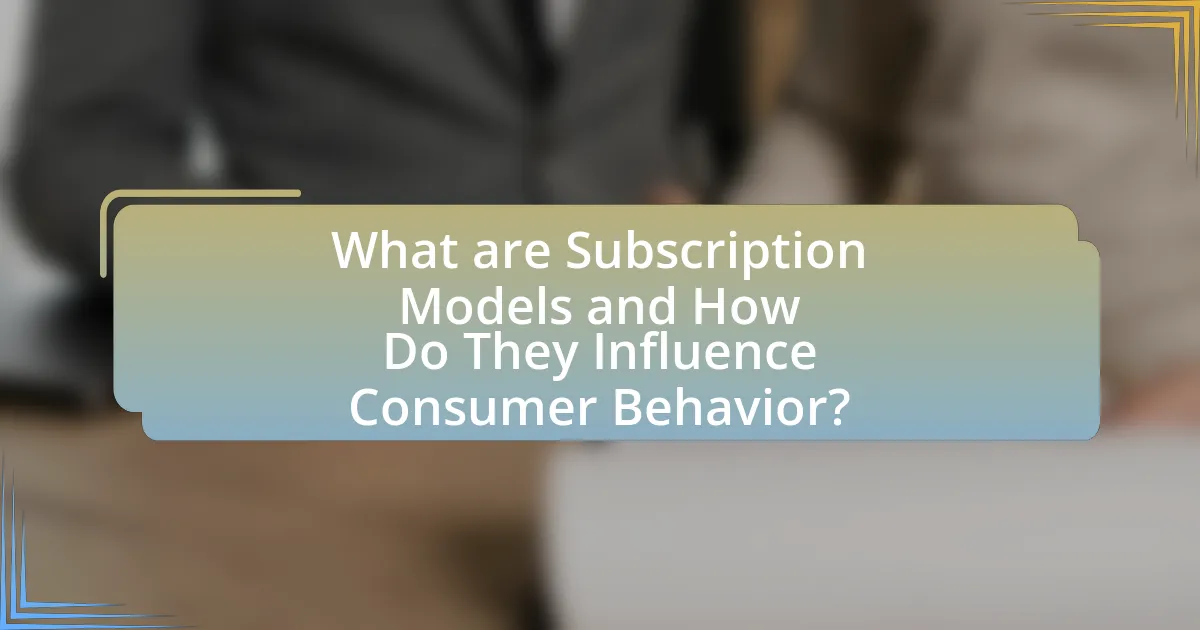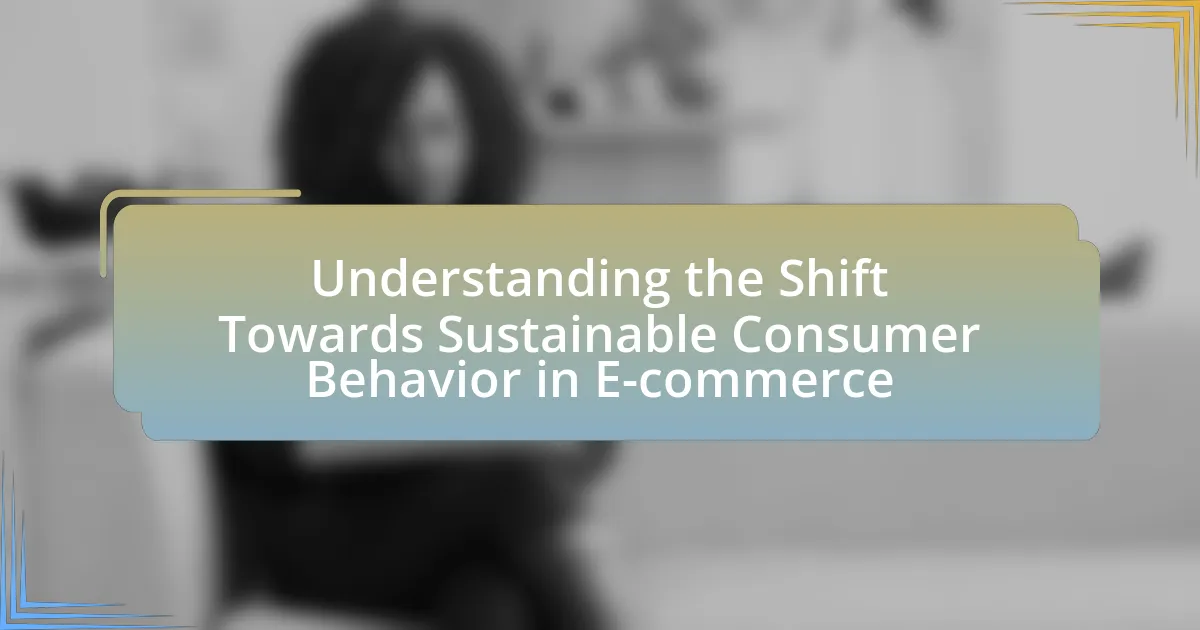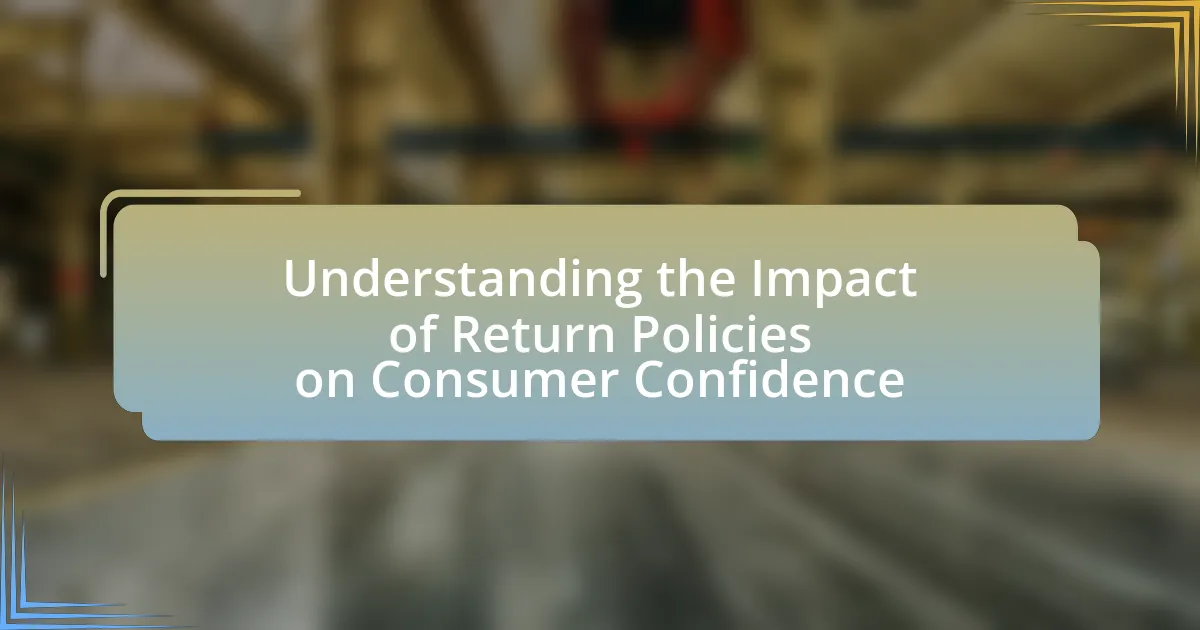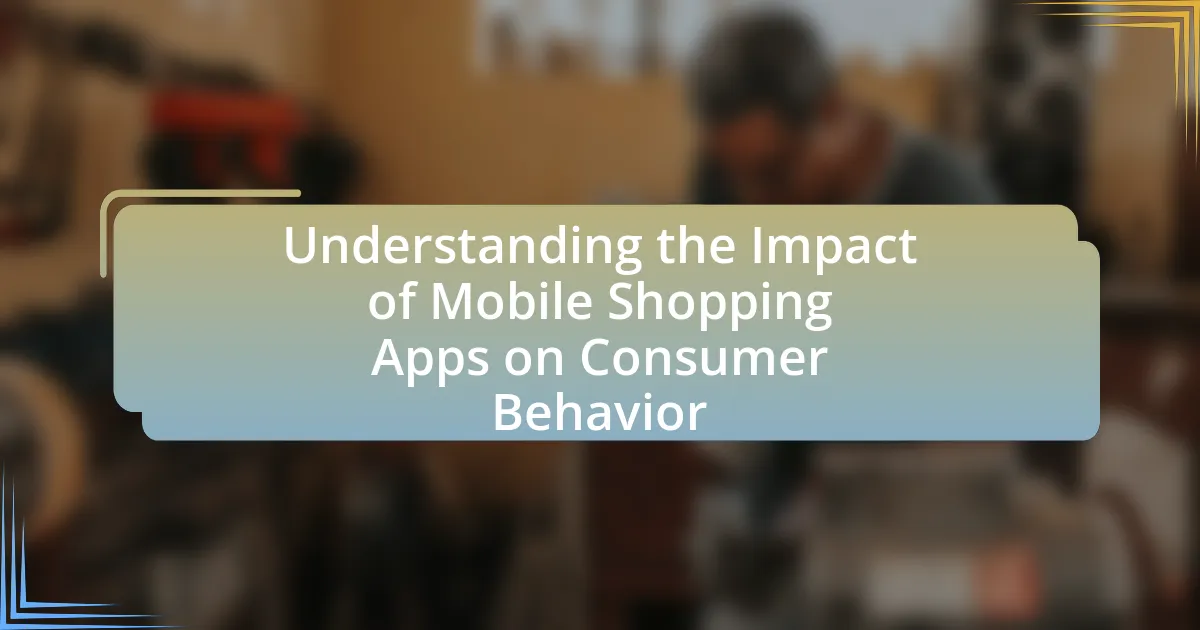Subscription models are business strategies that provide consumers with ongoing access to products or services for a recurring fee, significantly influencing consumer behavior and purchasing patterns. These models foster commitment and convenience, leading to increased customer loyalty and reduced churn rates. The article explores how subscription models differ from traditional purchasing methods, their key characteristics, and the factors driving their popularity, including consumer demand for personalized experiences and cost-effectiveness. Additionally, it examines the impact of subscription services on consumer spending habits, brand loyalty, and the challenges businesses face in implementing these models, while also providing strategies for optimizing subscription offerings and enhancing customer retention.

What are Subscription Models and How Do They Influence Consumer Behavior?
Subscription models are business strategies that provide consumers with access to products or services for a recurring fee, typically on a monthly or annual basis. These models influence consumer behavior by fostering a sense of commitment and convenience, leading to increased customer loyalty and reduced churn rates. Research indicates that 70% of consumers prefer subscription services for their convenience and cost-effectiveness, as they often provide savings compared to one-time purchases. Additionally, subscription models can create a habitual purchasing pattern, as consumers are more likely to continue using a service they have already committed to financially. This behavior is supported by the fact that subscription services often utilize personalized recommendations and curated experiences, further enhancing consumer engagement and satisfaction.
How do subscription models differ from traditional purchasing methods?
Subscription models differ from traditional purchasing methods primarily in their payment structure and consumer commitment. In subscription models, consumers pay a recurring fee for access to products or services over a specified period, which fosters ongoing engagement and loyalty. In contrast, traditional purchasing methods involve a one-time payment for ownership of a product, leading to a transactional relationship without ongoing commitment.
For example, the subscription box industry has grown significantly, with a market size reaching approximately $15 billion in 2020, indicating a shift in consumer preferences towards continuous access rather than outright ownership. This model allows businesses to predict revenue streams and maintain customer relationships over time, unlike traditional methods that often result in sporadic purchases.
What are the key characteristics of subscription models?
Subscription models are characterized by recurring payments for access to products or services over a specified period. These models typically include features such as convenience, predictability in revenue for businesses, and enhanced customer loyalty. For instance, companies like Netflix and Spotify utilize subscription models to provide continuous access to content, which fosters user engagement and retention. Additionally, subscription models often offer tiered pricing structures, allowing consumers to choose plans that best fit their needs, thereby increasing market reach and customer satisfaction.
How do subscription models create a sense of commitment among consumers?
Subscription models create a sense of commitment among consumers by establishing ongoing relationships that encourage regular engagement and investment. These models often involve automatic renewals and recurring payments, which psychologically bind consumers to the service, making them less likely to cancel. Research indicates that consumers perceive subscriptions as a long-term commitment, leading to increased loyalty; for instance, a study by McKinsey & Company found that subscription services can increase customer retention rates by up to 60%. This commitment is further reinforced by the personalization and tailored experiences that many subscription services offer, making consumers feel valued and understood.
Why are subscription models becoming increasingly popular?
Subscription models are becoming increasingly popular due to their ability to provide convenience and cost-effectiveness for consumers. These models allow users to access products or services on a recurring basis, often at a lower upfront cost compared to traditional purchasing methods. For instance, a report by McKinsey & Company indicates that subscription services have grown by more than 100% annually over the past five years, highlighting a significant shift in consumer preferences towards this purchasing method. Additionally, the predictability of subscription payments helps consumers manage their budgets more effectively, while businesses benefit from steady revenue streams and improved customer loyalty.
What factors contribute to the rise of subscription services?
The rise of subscription services is primarily driven by consumer demand for convenience, cost-effectiveness, and personalized experiences. Convenience is evident as subscription models allow consumers to access products and services without the need for repeated purchases, exemplified by platforms like Netflix and Spotify, which provide instant access to vast libraries of content. Cost-effectiveness is highlighted by the ability to spread payments over time, making high-value items more accessible; for instance, subscription boxes often offer products at a lower cumulative cost than purchasing items individually. Personalized experiences enhance customer satisfaction, as many subscription services utilize data analytics to tailor offerings to individual preferences, leading to increased customer loyalty. According to a report by McKinsey & Company, subscription services have grown by more than 100% annually over the past five years, indicating a significant shift in consumer buying patterns towards this model.
How do consumer preferences shape the development of subscription models?
Consumer preferences significantly influence the development of subscription models by driving businesses to tailor offerings that align with customer desires for convenience, personalization, and value. For instance, the rise of streaming services like Netflix and Spotify demonstrates how consumer demand for on-demand access to content has led to subscription models that prioritize user experience and flexibility. Research indicates that 70% of consumers prefer subscription services for their perceived cost-effectiveness and ease of use, prompting companies to innovate and diversify their subscription options to meet these expectations. This alignment between consumer preferences and subscription offerings fosters customer loyalty and enhances market competitiveness.
What impact do subscription models have on consumer buying patterns?
Subscription models significantly alter consumer buying patterns by promoting habitual purchasing and reducing the friction associated with transactions. These models encourage consumers to commit to regular payments, which can lead to increased brand loyalty and a tendency to buy more frequently. Research indicates that 70% of consumers are more likely to purchase from brands they subscribe to, as subscriptions create a sense of convenience and predictability in spending. Additionally, subscription services often utilize personalized recommendations based on consumer behavior, further influencing buying decisions and increasing overall spending.
How do subscription models affect consumer spending habits?
Subscription models significantly influence consumer spending habits by promoting consistent, often impulsive purchases. These models encourage consumers to commit to regular payments for services or products, which can lead to increased overall spending compared to traditional one-time purchases. For instance, a study by McKinsey & Company found that subscription services can increase consumer spending by 100% or more over a year, as consumers often underestimate the cumulative cost of multiple subscriptions. Additionally, the convenience and perceived value of subscriptions can lead to a tendency to subscribe to multiple services, further amplifying spending.
What role do subscription models play in brand loyalty?
Subscription models significantly enhance brand loyalty by creating a consistent and predictable revenue stream for businesses while fostering a deeper relationship with consumers. These models encourage ongoing engagement through regular interactions, which can lead to increased customer satisfaction and retention. For instance, a study by McKinsey & Company found that subscription services can increase customer lifetime value by up to 300% compared to traditional purchasing methods. This is largely due to the convenience and perceived value that subscriptions offer, making customers more likely to remain loyal to brands that provide them.
How do subscription models transition consumer expectations?
Subscription models transition consumer expectations by creating a sense of convenience and predictability in purchasing behavior. These models allow consumers to access products or services on a recurring basis, which shifts their focus from one-time purchases to ongoing relationships with brands. For instance, a study by McKinsey & Company found that 15% of consumers have subscribed to at least one service, indicating a growing acceptance of this purchasing method. This shift leads consumers to expect seamless experiences, personalized offerings, and consistent value, ultimately redefining their interactions with brands and influencing their buying patterns.
What challenges do businesses face when implementing subscription models?
Businesses face several challenges when implementing subscription models, including customer acquisition, retention, and pricing strategy. Customer acquisition can be difficult due to the need for effective marketing to convey the value of the subscription, as evidenced by a 2021 study from McKinsey, which found that 60% of consumers are hesitant to commit to subscriptions without clear benefits. Retention poses another challenge, as businesses must continuously deliver value to prevent churn; research indicates that acquiring a new customer can cost five times more than retaining an existing one. Additionally, determining the right pricing strategy is crucial, as mispricing can lead to lost revenue or customer dissatisfaction, with studies showing that 70% of subscription services fail due to pricing issues.
What are the different types of subscription models available?
The different types of subscription models available include flat-rate, tiered, usage-based, freemium, and hybrid models. Flat-rate models charge a single price for access to a service or product, commonly seen in streaming services like Netflix. Tiered models offer multiple pricing levels based on features or usage, such as cloud storage services like Dropbox. Usage-based models charge customers based on their consumption, exemplified by utilities or services like AWS. Freemium models provide basic services for free while charging for premium features, as seen in software applications like Spotify. Hybrid models combine elements of various types, allowing for flexibility and customization, often utilized by companies like Adobe. These models cater to diverse consumer preferences and can significantly influence buying patterns by providing tailored options.
How do product-based subscriptions differ from service-based subscriptions?
Product-based subscriptions provide physical goods to consumers on a recurring basis, while service-based subscriptions offer access to services or digital content. For example, a product-based subscription like a meal kit delivers ingredients and recipes regularly, whereas a service-based subscription like a streaming platform grants access to movies and shows. The key difference lies in the nature of what is delivered: tangible products versus intangible services. This distinction influences consumer buying patterns, as product-based subscriptions often emphasize convenience and variety, while service-based subscriptions focus on ongoing access and engagement.
What are the advantages and disadvantages of various subscription models?
Various subscription models offer distinct advantages and disadvantages that influence consumer buying patterns. Advantages include predictable revenue for businesses, which can lead to improved cash flow and customer loyalty through ongoing engagement. For example, companies like Netflix benefit from a steady income stream, allowing for consistent investment in content. Disadvantages encompass potential customer fatigue due to subscription overload, where consumers may feel overwhelmed by multiple subscriptions, leading to cancellations. Additionally, some models may lack flexibility, as consumers are often locked into long-term commitments, which can deter new customers. Research indicates that 30% of consumers have canceled a subscription due to dissatisfaction with value, highlighting the importance of balancing offerings with consumer expectations.
What strategies can businesses employ to optimize subscription models?
Businesses can optimize subscription models by implementing tiered pricing structures that cater to different customer segments. This strategy allows companies to attract a broader audience by offering various levels of service at different price points, thereby increasing overall subscription uptake. For instance, a study by McKinsey & Company found that companies using tiered pricing can see a revenue increase of up to 20% as they appeal to both budget-conscious consumers and those willing to pay more for premium features. Additionally, businesses should focus on enhancing customer engagement through personalized content and regular communication, which can lead to higher retention rates. Research indicates that personalized experiences can increase customer satisfaction by 20%, further solidifying the value of subscription services.
How can businesses enhance customer retention in subscription services?
Businesses can enhance customer retention in subscription services by providing personalized experiences and consistent value. Personalization can be achieved through data analytics, allowing businesses to tailor offerings based on individual customer preferences and behaviors. For instance, a study by McKinsey & Company found that personalization can lead to a 10-30% increase in customer retention rates. Additionally, maintaining consistent value through regular updates, exclusive content, or loyalty rewards keeps customers engaged and satisfied. Research from Bain & Company indicates that increasing customer retention by just 5% can boost profits by 25-95%, demonstrating the financial benefits of effective retention strategies.
What metrics should businesses track to measure subscription success?
Businesses should track metrics such as Monthly Recurring Revenue (MRR), Customer Lifetime Value (CLV), Churn Rate, and Customer Acquisition Cost (CAC) to measure subscription success. MRR provides a clear view of predictable revenue, while CLV indicates the total revenue expected from a customer over their relationship with the business. Churn Rate measures the percentage of subscribers who cancel, highlighting retention issues, and CAC assesses the cost-effectiveness of acquiring new customers. These metrics collectively offer insights into financial health and customer engagement, essential for optimizing subscription models.
What best practices should consumers consider when choosing subscription services?
Consumers should consider evaluating the value and relevance of subscription services before committing. This involves assessing whether the service aligns with their needs and preferences, as well as comparing costs against the benefits provided. Research indicates that 70% of consumers cancel subscriptions due to lack of perceived value, highlighting the importance of ensuring that the service meets their expectations. Additionally, consumers should review cancellation policies and trial periods, as these factors can significantly impact their overall satisfaction and financial commitment.





